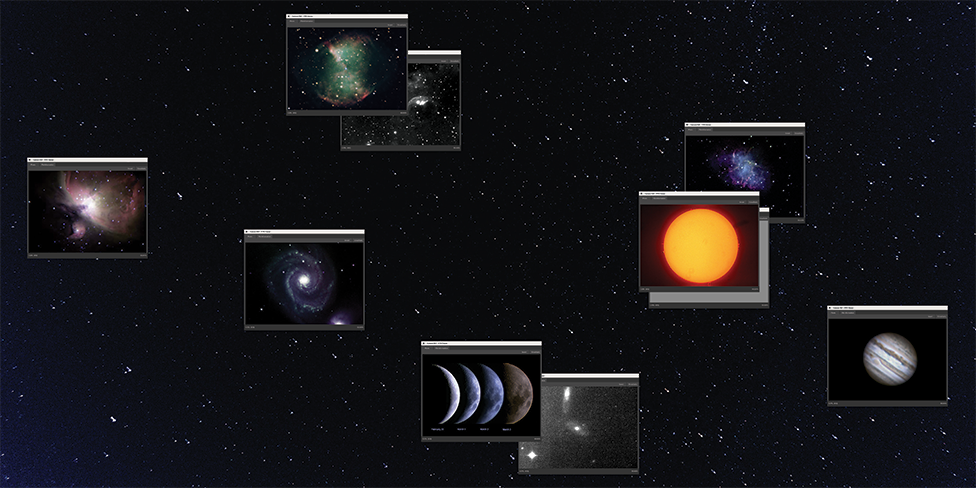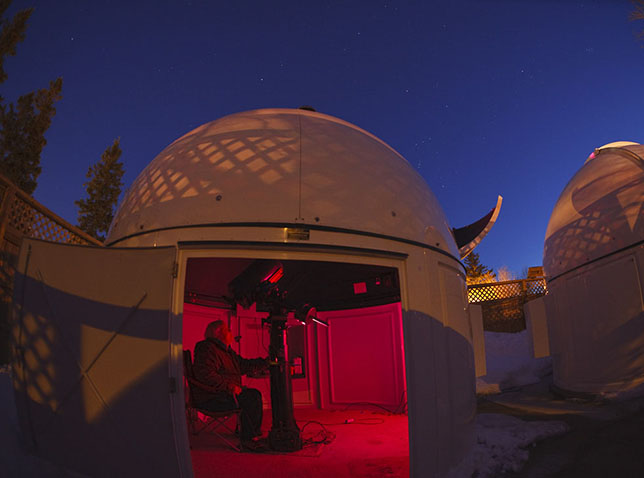There’s a sharper view of the sky than ever at York University. The two sticky, stubborn telescope domes that had sat atop York’s Allan I. Carswell Astronomical Observatory since the 1960s were finally replaced this past summer. It was no easy effort. Even after securing approval for the renovation and removing the old domes from the building by crane, staff spent a week assembling the two new domes, each one nearly seven metres in diameter, before hefting them into place.
The new equipment is fully mechanical and can be remotely controlled through a computer rather than manually adjusted – an upgrade that observatory director and York astrophysics professor Elaina Hyde says has opened the Toronto facility to a wider, web- based audience.
It was no easy investment, or a small one, but it allows researchers unprecedented freedom to do their work. The new domes are part of a larger renovation project partially funded through a $500,000 donation from the Carswell Family Foundation, which provides funding for education- and health-related charitable activities. York and its faculty of science matched the donation with alumni support, bringing the total funds spent to $1 million.
With this funding, the university started improvements to the observatory a few years before the domes were installed – most notably, in 2020, it added a one-metre telescope to its collection of 60-, 40- and 20-centimetre telescopes. However, the pandemic and its stay-at-home orders hastened the need to make the site accessible to those working off campus. Online outreach is now a central priority for the observatory. Some of these initiatives include a YouTube channel, which hosts livestreamed night-sky viewings and an astronomy series called TeleTube; an online radio show; games; online tours; and platforms to connect students, academics or members of the public working anywhere in the world directly with university personnel.
The upgrade at York is just one corner of growth in Canadian university-based astronomy. From coast to coast, university observatories are upgrading aging infrastructure to make them more resilient for remote work and to expand their reach beyond campus. The COVID-19 pandemic has ramped up renovations to astronomy observatories at a pace not seen since the 1960s. At that time, the surprise launch of the Soviet satellite Sputnik in 1957 kicked off the space race and inspired the United States and Canada to pour money into science, astronomy and aerospace projects. Many Canadian observatories date back to this era and now, at more than 60 years old, they’re ready for new life.
Stargazing on Campus
Several Canadian university campuses feature state-of-the-art astronomical observatories that regularly open their doors to the public. These facilities offer significant teaching and research opportunities for students and faculty members, but they are equally valuable as public outreach arms for the universities.
When the pandemic shut down university campuses and their observatories throughout much of 2020 and 2021, technological renovations like those seen at York became all the more urgent. Fortunately, the transition was already well underway at several institutions and many were able to build off of these slow-but-steady improvements.
The Burke-Gaffney Observatory (BGO) at Saint Mary’s University in Halifax installed a new 0.6-metre telescope in 2013 – along with the required instrumentation, mount, automated dome rotation, cloud sensors and other necessities – thanks largely to a donation by real estate developer and philanthropist Ralph Medjuck (the telescope was even named after its benefactor). Two years later, in 2015, the BGO launched a new interface allowing the public to request astronomical images from the telescope through Twitter. Since then, the BGO has touted itself as the world’s first social media-controlled observatory.
“With our robotic interface and remotely controlled operations, we were really prepared for what happened [during the pandemic],” says Vincent Hénault-Brunet, BGO director and an assistant professor with SMU’s department of astronomy and physics. “Observations continued throughout the pandemic and students continued to use the BGO for class projects, sometimes sending observing requests to be executed later, sometimes joining a live, remote observing session,” Dr. Hénault-Brunet adds. Observatories have long served as public outreach arms for universities. With remote access to observatory equipment, programs and data on the rise, observatory outreach is finding new ground.
The team at the University of Calgary’s Rothney Astrophysical Observatory (RAO) is using recent equipment updates to lean hard into remote outreach opportunities. The RAO is home to two telescopes that are completely controllable over the internet: the Clark-Milone telescope, which was recently upgraded with a new digital camera, called a complementary metal oxide semiconductor; and the Baker-Nunn telescope, which is now connected to the international Skynet Robotic Telescope Network, based out of the University of North Carolina. Pre-pandemic, RAO estimated some 10,000 visitors a year to its programs. With these web-based tools in place, the observatory is working to build on that. Recently, they’ve focused on engagement with local Indigenous communities and public schools, including through workshops for Calgary science teachers, says RAO director Phil Langill.
Occasionally, some institutions, like the Université de Moncton, will opt to invest in smaller telescopes that allow for more location flexibility – advanced optical technologies and materials make today’s small telescopes much more powerful than those made six decades ago.
“We bought 12-inch [30.5-centimetre] telescopes that are mobile, that we can move,” says Viktor Khalack, a professor of physics and astronomy at U de Moncton. The institution’s program is focusing on the coming “solar maximum” – a peak of sunspot activity and solar flares that happens roughly every 11 years on the sun – and portable equipment will be key to keeping track of it, he says. The next peak is forecasted to happen between November 2024 and March 2026, according to the U.S. Solar Cycle Prediction Panel. Already the sun is showing off its power with flares, ejections of charged particles and other activities – and the public loves the chance to look at it safely through telescopes, Dr. Khalack explains.
“You can see nice chains [of sunspots] and you can try to measure solar rotations as well,” he notes, adding that these moments of engagement are inspiring for kids and for those who may be considering astronomy studies in the future.
At the time of publication, Canadian universities have gone back to inperson learning with few restrictions. Still, the past few years have made it clear that resilience and flexibility must be built into university observing programs and facilities. This need will only grow in the coming decades as researchers and community members face significant barriers to accessing physical observatories, including the cost and environmental impact of travelling to these facilities, but also the more mundane challenges like illness and caregiving responsibilities.
Despite these challenges, staff at university observatories say they feel better prepared to respond to what may come with remote observing programs in place. But keeping these programs will take ongoing financial support and investment from a variety of sources.
“It’s all related to funding,” Dr. Khalack says, including federal government funding, which, he adds, would “be most appreciated.”
“Telescope and detector upgrades are always on the go,” adds Dr. Langill at U of Calgary. The associate professor of astrophysics and astronomy notes that staying on top of cutting-edge research must happen even in years when dollars aren’t flowing easily to the university. The money spent now will have an impact that lasts for decades.


















